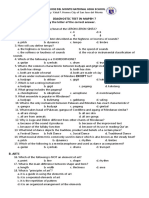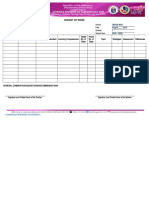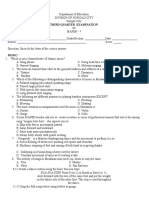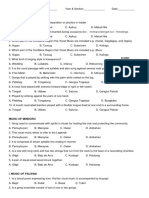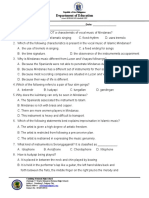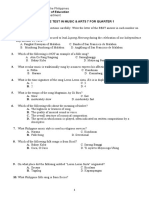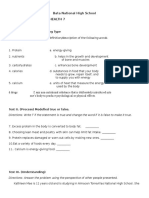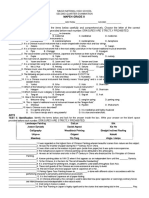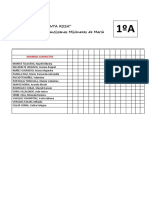100%(1)100% found this document useful (1 vote)
292 viewsPretest-Mapeh 7
Pretest-Mapeh 7
Uploaded by
Roy Ivan Manuel ReyesThis document contains a 15-item pre-test on MAPEH (Music, Arts, Physical Education, and Health) topics. The questions cover areas like elements of music, Filipino musical traditions, functions of music during Spanish colonization, physical fitness concepts, and art forms introduced during Spanish colonial period in the Philippines. The test aims to assess understanding of concepts in music, arts, physical education, and health that are part of the MAPEH subject.
Copyright:
© All Rights Reserved
Available Formats
Download as DOCX, PDF, TXT or read online from Scribd
Pretest-Mapeh 7
Pretest-Mapeh 7
Uploaded by
Roy Ivan Manuel Reyes100%(1)100% found this document useful (1 vote)
292 views1 pageThis document contains a 15-item pre-test on MAPEH (Music, Arts, Physical Education, and Health) topics. The questions cover areas like elements of music, Filipino musical traditions, functions of music during Spanish colonization, physical fitness concepts, and art forms introduced during Spanish colonial period in the Philippines. The test aims to assess understanding of concepts in music, arts, physical education, and health that are part of the MAPEH subject.
Original Description:
mapeh 7
Original Title
pretest-mapeh 7
Copyright
© © All Rights Reserved
Available Formats
DOCX, PDF, TXT or read online from Scribd
Share this document
Did you find this document useful?
Is this content inappropriate?
This document contains a 15-item pre-test on MAPEH (Music, Arts, Physical Education, and Health) topics. The questions cover areas like elements of music, Filipino musical traditions, functions of music during Spanish colonization, physical fitness concepts, and art forms introduced during Spanish colonial period in the Philippines. The test aims to assess understanding of concepts in music, arts, physical education, and health that are part of the MAPEH subject.
Copyright:
© All Rights Reserved
Available Formats
Download as DOCX, PDF, TXT or read online from Scribd
Download as docx, pdf, or txt
100%(1)100% found this document useful (1 vote)
292 views1 pagePretest-Mapeh 7
Pretest-Mapeh 7
Uploaded by
Roy Ivan Manuel ReyesThis document contains a 15-item pre-test on MAPEH (Music, Arts, Physical Education, and Health) topics. The questions cover areas like elements of music, Filipino musical traditions, functions of music during Spanish colonization, physical fitness concepts, and art forms introduced during Spanish colonial period in the Philippines. The test aims to assess understanding of concepts in music, arts, physical education, and health that are part of the MAPEH subject.
Copyright:
© All Rights Reserved
Available Formats
Download as DOCX, PDF, TXT or read online from Scribd
Download as docx, pdf, or txt
You are on page 1of 1
Pre-Test MAPEH 7
1. Which of the following does NOT belong to the group?
A. Rhythm and melody C. Tempo and timbre
B. Texture and dynamics D. Creativity and style.
2. Our ancestors are very artistic in nature they become creative with the help of which?
A. Natural resources present in the locality.
B. Indigenous materials imported from nearby places.
C. Native resources introduced by the conquistadores.
D. Artificial foods exchanged during early times.
3. Which of the following does not convey a positive idea?
A. Preparations last only a day.
B. Talents are being exposed when there is celebration.
C. Filipinos never miss an occasion without celebration.
D. Filipinos really spending more than enough financial and time just to celebrate any occasion.
4. The following are concept of “art and belief/religion” except for?
A. Art is used to instruct and worship.
B. Art is used to inspire feeling of devotion
C. Art is used to impress and to convert non-believers
D. Art is used to attack or to fight other religious philosophy
5. The ability to perform daily activities/routine without undue fatigue.
A. Physical fitness C. Lifestyle
B. Wellness D. Fitness continuum
6. Health related-fitness: functioning of the body as Skill related-fitness:____________________?
A. Quality of skill movements C. Amount of energy used
B. Number tries D. All of the above
7. Mr. Valoria is fun of playing basketball but still he has to practice dribbling while walking to develops his;
A. Agility C. Balance
B. Coordination D. Flexibility
8. The recent Palarong Pambansa held at Subic, Zambales lined-up different events, one of this is running. A delegate
from Maguindanao says that winning the said event needs practice to develop _____?
A. Power C. Fastness
B. Speed D. Agility
9. Which of the four statements DOES NOT describe Filipino music?
A. Musical traditions are diverse.
B. Different ethnic groups from all over the country have many common musical instruments and life cycle
functions but vary in properties.
C. Prior to the coming of conquistadores, the early natives already had their musical instruments and traditional
songs.
D. Grand piano was used as the main musical instrument by our early ancestors in their cultural performances and
dances.
10. Which of the following is the function of music during Spanish colonization?
A. For worship C. Systematic way of conveying people to hate the religion
B. Devotions to anito’s D. Promotion of revolution
11. The art of combining sounds of varying pitches to produce melodious sound.
A. Sounds C. Music
B. Songs D. Instruments.
12. The sound is produced by the vibration of air.
A. Aerophone C. Brass
B. String D. Percussion
13. We can express art through the following, EXCEPT for.
A. Action and gesture C. Facial expressions
B. Style of talking and movement D. Dreaming
14. It tells about the life of Jesus brought to us by the Spanish.
A. Pasyon and Senakulo C. Harana
B. Kundiman D. Epic
15. 30. American:Education as Spanish: ______.
A. Culture C. Religion
B. Art D. Leadership
You might also like
- StarWars Flute ChoirDocument17 pagesStarWars Flute ChoirRicardo Ross83% (6)
- Simandl Bass Method-Book 2Document80 pagesSimandl Bass Method-Book 2Renan Chamberlain88% (8)
- Action Plan Mapeh ViiiDocument3 pagesAction Plan Mapeh ViiiGerard Andres BalosbalosNo ratings yet
- Spa Dance III ExamDocument2 pagesSpa Dance III ExamBella StellinaNo ratings yet
- Diagnostic Test in Mapeh 7Document4 pagesDiagnostic Test in Mapeh 7Rogerson Pena75% (4)
- Lesson Plan For HealthDocument3 pagesLesson Plan For HealthEric Pascual IndieNo ratings yet
- Toefl Itp Reading ComprehensionDocument7 pagesToefl Itp Reading ComprehensionZunarto SaputraNo ratings yet
- Second Quarter Exam in Mapeh 7Document5 pagesSecond Quarter Exam in Mapeh 7Maricris DomosmogNo ratings yet
- Third QuarterDocument4 pagesThird Quarterreynilo100% (1)
- Grade 7 - 1 MAPEH First Periodic ExamDocument3 pagesGrade 7 - 1 MAPEH First Periodic ExamAngelica B. AmmugauanNo ratings yet
- Llamera National High SchoolDocument3 pagesLlamera National High SchoolGladez Lucaya GalagaranNo ratings yet
- Item Analysis Mapeh 7Document10 pagesItem Analysis Mapeh 7Telin TatangNo ratings yet
- 3rd Quarter Mapeh 7Document4 pages3rd Quarter Mapeh 7JoeresaKyleZerdaIbarra100% (1)
- 1st Periodical MAPEH 7Document6 pages1st Periodical MAPEH 7karla joy 05No ratings yet
- Long Quiz in Music 7 Q3Document3 pagesLong Quiz in Music 7 Q3Precious Nowelene Venturina100% (1)
- 2nd Quarter ExaminationDocument4 pages2nd Quarter Examinationromeojr sibullasNo ratings yet
- Diagnostic Test Mapeh 8Document4 pagesDiagnostic Test Mapeh 8Precious CruzNo ratings yet
- Pre-Test in Arts 7 First Quarter: School Year 2018-2019Document2 pagesPre-Test in Arts 7 First Quarter: School Year 2018-2019La Donna100% (3)
- 1Q Summative For Arts For MAPEH 7Document1 page1Q Summative For Arts For MAPEH 7Dhaensiele D. Guzman100% (1)
- MAPEH 7 1st Quarter ExamDocument5 pagesMAPEH 7 1st Quarter ExamMark Anthony C. SaspaNo ratings yet
- Music QUIZ For G7 2nd GradingDocument2 pagesMusic QUIZ For G7 2nd GradingEj EscasaNo ratings yet
- Music 7 q3 Summative TestDocument4 pagesMusic 7 q3 Summative TestSuoerman Almoneda100% (1)
- Bow Mapeh 7 3RD QuarterDocument2 pagesBow Mapeh 7 3RD QuarterNas LeeNo ratings yet
- Periodical Exam in Mapeh 7Document2 pagesPeriodical Exam in Mapeh 7cattleya abelloNo ratings yet
- MAPEH 7 3rd Summative TestDocument5 pagesMAPEH 7 3rd Summative TestFerlyn Bautista Pada100% (1)
- Summative 7-Music ArtsDocument5 pagesSummative 7-Music ArtsJANE ONG100% (1)
- Mapeh 7 2ND Q Exam 21 22 LinternaDocument6 pagesMapeh 7 2ND Q Exam 21 22 LinternaJOANNE DANDOYNo ratings yet
- Music 9 DLL 2nd QuarterDocument2 pagesMusic 9 DLL 2nd QuarterJennifer KreezNo ratings yet
- 4th Periodical Test G7 MAPEHDocument3 pages4th Periodical Test G7 MAPEHGladys Javier Pato100% (3)
- Mapeh Diagnostic TestDocument8 pagesMapeh Diagnostic TestIceyYamaha100% (1)
- DLL - MusicDocument3 pagesDLL - MusicIvy CaneteNo ratings yet
- Summative Exam in Mapeh 7 Q3Document5 pagesSummative Exam in Mapeh 7 Q3Angelica SantomeNo ratings yet
- Arts7 - First QuarterDocument6 pagesArts7 - First QuarterMORENO BACO100% (1)
- Third Quarter Mapeh 8: Junior High School Department Labo, Camarines Norte S.Y. 2020-2021Document22 pagesThird Quarter Mapeh 8: Junior High School Department Labo, Camarines Norte S.Y. 2020-2021Joyce Anne De Vera Ramos100% (1)
- Quarter 4, Week 1-2 Summative Test:: Concept Notes With Formative ActivitiesDocument5 pagesQuarter 4, Week 1-2 Summative Test:: Concept Notes With Formative ActivitiesRuth AramburoNo ratings yet
- MAPEH 7 1st Quarter ExamDocument5 pagesMAPEH 7 1st Quarter ExamJoseph Miraflor0% (1)
- Third Periodic Exam in Mapeh 7Document13 pagesThird Periodic Exam in Mapeh 7MA. CECILIA U. CUATRIZNo ratings yet
- DLL 4th Quarter Health Feb. 11-15, 2019Document9 pagesDLL 4th Quarter Health Feb. 11-15, 2019Thirdy MaraveNo ratings yet
- Summative Assessment 1 MOVEMENT ANALYSIS: Locomotor and Non Locomotor MovementDocument2 pagesSummative Assessment 1 MOVEMENT ANALYSIS: Locomotor and Non Locomotor MovementMark Shawen MI�ASNo ratings yet
- Second Periodic ExaminationDocument2 pagesSecond Periodic ExaminationDorlenn Peñaredondo HiponiaNo ratings yet
- Grade 7 MapehDocument2 pagesGrade 7 MapehJhie Manlogon100% (1)
- Summative Test in Health 8Document2 pagesSummative Test in Health 8Jenny Rose Peralta0% (1)
- Q2 Exam in Music and Arts 7 2Document4 pagesQ2 Exam in Music and Arts 7 2Sarah Visperas Rogas100% (1)
- Diagnostic Test in MAPEH 8Document5 pagesDiagnostic Test in MAPEH 8Roumel GalvezNo ratings yet
- 2nd Grading Test Paper MAPEHDocument3 pages2nd Grading Test Paper MAPEHAlleli Faith LeyritanaNo ratings yet
- Mapeh 8Document3 pagesMapeh 8kevin100% (1)
- Mapeh 7 4TH Quarter ExamDocument3 pagesMapeh 7 4TH Quarter ExamJenn Carano-oNo ratings yet
- Veridiano Academy Foundation Sto - Niño, CagayanDocument2 pagesVeridiano Academy Foundation Sto - Niño, CagayanJestoni Ambrocio100% (1)
- Unit Test Mapeh 7Document4 pagesUnit Test Mapeh 7Nhey CawiganNo ratings yet
- 1st Quarter LAS No. 1 in Music 7 Week 1Document8 pages1st Quarter LAS No. 1 in Music 7 Week 1Niño Embile DellomasNo ratings yet
- Grade 7 Music 1ST QuarterDocument13 pagesGrade 7 Music 1ST Quartersanjosenighthighschool taclobancity100% (3)
- Diagnostic Test in MAPEHDocument4 pagesDiagnostic Test in MAPEHNikkiBoy Reyes BernabeNo ratings yet
- First Quarter in Mapeh 8Document3 pagesFirst Quarter in Mapeh 8Regine BoridorNo ratings yet
- 2nd Quarter Tos in Mapeh 7 1Document1 page2nd Quarter Tos in Mapeh 7 1Mark Glenn Gelvezon Ape0% (1)
- Q4 Grade-9-Tq MAPEHDocument3 pagesQ4 Grade-9-Tq MAPEHJunrel SapantaNo ratings yet
- Grade 7 Third QuarterDocument5 pagesGrade 7 Third QuarterRoderick Beltran Lutang100% (1)
- Name: - Teacher: - Gade and Section: - DateDocument3 pagesName: - Teacher: - Gade and Section: - DateDhess Mulleda MantalaNo ratings yet
- 2nd Grading Exam in MAPEH 7Document1 page2nd Grading Exam in MAPEH 7RegeneCervantes75% (4)
- Q2 Health 7 Summative TestDocument2 pagesQ2 Health 7 Summative TestJc Vallente100% (1)
- Fourth Periodical Test in MAPEH7 ArtDocument2 pagesFourth Periodical Test in MAPEH7 ArtMary Grace Geronimo SalaysayNo ratings yet
- Fourth Quarter - Consolidated - Summative Assessment Tool-In Mapeh 8Document5 pagesFourth Quarter - Consolidated - Summative Assessment Tool-In Mapeh 8Annaliza HabonNo ratings yet
- First Periodic Test MAPEHDocument4 pagesFirst Periodic Test MAPEHDolinor Mae Bringino BuendiaNo ratings yet
- Summative-in-MAPEH-grade-7 (1st Quarter)Document4 pagesSummative-in-MAPEH-grade-7 (1st Quarter)Cristina TemajoNo ratings yet
- Distance vs. DisplacementDocument2 pagesDistance vs. DisplacementRoy Ivan Manuel ReyesNo ratings yet
- Region 4 and 5Document80 pagesRegion 4 and 5Roy Ivan Manuel ReyesNo ratings yet
- Religious FestivalsDocument5 pagesReligious FestivalsRoy Ivan Manuel ReyesNo ratings yet
- Programme: Mr. Herdie SalazarDocument2 pagesProgramme: Mr. Herdie SalazarRoy Ivan Manuel ReyesNo ratings yet
- Ang Suriansa at Ang Pagpapaunlad NG Wikang PambansaDocument38 pagesAng Suriansa at Ang Pagpapaunlad NG Wikang PambansaDorothy MaglenteNo ratings yet
- Certification Checking of FormsDocument1 pageCertification Checking of FormsRoy Ivan Manuel ReyesNo ratings yet
- Shs Reqs Materialsfacilities and Equipment Artsdesign StemDocument12 pagesShs Reqs Materialsfacilities and Equipment Artsdesign StemRoy Ivan Manuel ReyesNo ratings yet
- SHS Core - Reading and Writing CG PDFDocument8 pagesSHS Core - Reading and Writing CG PDFRoy Ivan Manuel Reyes67% (6)
- SRI Lanka: 7. Food & Delicacy 9. AccomodationDocument2 pagesSRI Lanka: 7. Food & Delicacy 9. AccomodationRoy Ivan Manuel ReyesNo ratings yet
- Essentials of Instructional Technology: Mudasir Hamid Malik Aqueel Ahmad PandithDocument66 pagesEssentials of Instructional Technology: Mudasir Hamid Malik Aqueel Ahmad PandithRoy Ivan Manuel ReyesNo ratings yet
- SHS Core - Oral Communication CGDocument7 pagesSHS Core - Oral Communication CGEstela Benegildo67% (3)
- Detailed Lesson PlanDocument1 pageDetailed Lesson PlanRoy Ivan Manuel ReyesNo ratings yet
- Teaching NonprojectedDocument30 pagesTeaching NonprojectedRoy Ivan Manuel ReyesNo ratings yet
- Elizabeth Barrett Browning Sonnet 32Document2 pagesElizabeth Barrett Browning Sonnet 32api-270897909100% (1)
- Ascensionism - Sleep TokenDocument2 pagesAscensionism - Sleep TokentaniajtattooNo ratings yet
- Thats What Grace Is For TJ Clay VL Clay RC Davis JR Solo MIDIDocument6 pagesThats What Grace Is For TJ Clay VL Clay RC Davis JR Solo MIDIClark Jan BernalesNo ratings yet
- Concerthall DesignDocument10 pagesConcerthall DesignAndra IleaNo ratings yet
- 7.integratiion Mapeh 9 Mark ZuckerbergDocument2 pages7.integratiion Mapeh 9 Mark Zuckerbergbernie evaristo bacsaNo ratings yet
- Listas VacíasDocument15 pagesListas VacíasMarco Antonio GuerreroNo ratings yet
- ADA Flanger ManualDocument11 pagesADA Flanger ManualNickNo ratings yet
- Chữa phiếu PRACTICE TEST 18Document6 pagesChữa phiếu PRACTICE TEST 18tleNo ratings yet
- Master of PuppetsDocument14 pagesMaster of PuppetsJohnGreenNo ratings yet
- Đề 11- Tự luyện chuyên AnhDocument6 pagesĐề 11- Tự luyện chuyên AnhNguyễn Thị Vi ThảoNo ratings yet
- Hal Leonard - Fingerpicking Elton JohnDocument84 pagesHal Leonard - Fingerpicking Elton JohnlucchiniNo ratings yet
- Orchestration and Arranging Lesson PlanDocument2 pagesOrchestration and Arranging Lesson Planapi-283554765No ratings yet
- Columbus, OH (Take Two Event)Document2 pagesColumbus, OH (Take Two Event)Abby SpalvieriNo ratings yet
- Folk Dances of Tamil NaduDocument9 pagesFolk Dances of Tamil NaduvedasriradhaNo ratings yet
- UAS Genap Bahasa Inggris Kelas 7Document6 pagesUAS Genap Bahasa Inggris Kelas 7KhalidRosyidiNo ratings yet
- Present Progressive - Test 1: Are AreDocument5 pagesPresent Progressive - Test 1: Are AreLaura DrNo ratings yet
- PocketPOD PresetsDocument1 pagePocketPOD PresetsDavid DetherageNo ratings yet
- Thanksgiving, Praise and WorshipDocument7 pagesThanksgiving, Praise and Worshipdi_fearnsNo ratings yet
- Johan Pachebell Canon Cuarteto DDocument48 pagesJohan Pachebell Canon Cuarteto Dronaldrs23No ratings yet
- Randfile 02Document40 pagesRandfile 02Sergio DiazNo ratings yet
- 10 Mandamientos Del DineroDocument5 pages10 Mandamientos Del DineroRecuperatu MenteNo ratings yet
- Taylor Swift SortDocument1 pageTaylor Swift SortDiyara SeneviratneNo ratings yet
- Nina Simone - The LifeDocument6 pagesNina Simone - The LifeOrion WalkerNo ratings yet
- Begin Again PDF PDFDocument6 pagesBegin Again PDF PDFJoao Victor Almeida SimoesNo ratings yet
- 海闊天空TABDocument9 pages海闊天空TABLouielam00No ratings yet
- Introduction To Triads and InversionsDocument13 pagesIntroduction To Triads and Inversionsdennis_robinson_1No ratings yet
- The King of Kings SATB FinalDocument4 pagesThe King of Kings SATB FinalHendry Tambunan100% (1)




